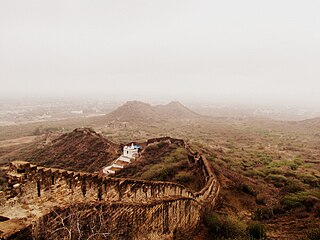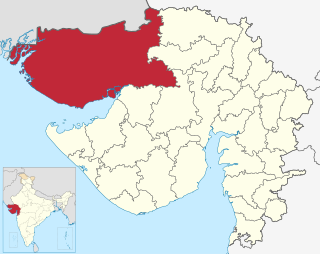Related Research Articles

Lakhpat is a sparsely populated town and sub-district in the Kachchh district in the Indian state of Gujarat located at the mouth of the Kori Creek. The town is enclosed by 7km-long, 18th-century fort walls.

Mian Ghulam Shah Kalhoro Sindhi: ميان غلام شاه ڪلهوڙو) was the ruler of the Kalhora Dynasty from 1758 when he was appointed ruler of Sindh by tribal Chiefs of Kalhora replacing his brother Mian Muradyab Kalhoro.
He was recognized and bestowed upon title of Shah Wardi Khan by Afghan King Ahmad Shah Durrani. He was able to bring stability in Sindh after the rule of Main Noor Mohammad Kalhoro; he reorganized the country and defeated the Marathas and their permanent vassal the Rao of Kutch near the Thar Desert and returned victoriousy. Ghulam Shah also ordered construction of the Shrine of Shah Abdul Latif Bhittai. The tomb of Ghulam Shah Kalhoro is situated in Hyderabad Sindh, Pakistan.

Maharao Pragmalji II, (1839−1875) was the Rao of Cutch, a ruler of Jadeja dynasty who ascended the throne upon death of his father & king Rao Deshalji II on 26 July 1860 and ruled till his death on 19 December 1875.

Bhujia Fort, also spelled as Bhujiya Fort, is a fort located in the outskirts of the town of Bhuj in the district of Kutch, Gujarat, India. The fort is built atop Bhujia Hill overlooking the town.

Cutch, also spelled Kutch or Kachchh and also historically known as the Kingdom of Kutch, was a kingdom in the Kutch region from 1147 to 1819 and a princely state under British rule from 1819 to 1947. Its territories covered the present day Kutch region of Gujarat north of the Gulf of Kutch. Bordered by Sindh in the north, Cutch State was one of the few princely states with a coastline.
Jara is a village near Bhuj in Kutch district of Gujarat, India.
Pipar is a village in Lakhpat Taluka of Kutch district of Gujarat, India.

Sandhan is a village on the coast of Gulf of Kutch about thirty miles west of Mandvi, in Abdasa Taluka of Kutch district of Gujarat, India.
Maharajadhiraj Mirza Maharao Bharmalji II was the Rao of Cutch belonging to Rajput dynasty, who ascended the throne of Princely State of Cutch one month after the death of his father Rayadhan III.
Rao Rayadhan III was the Rao of Cutch belonging to Jadeja Rajput dynasty, who ascended the throne of Princely State of Cutch in 1778 and ruled until 1786 when he was deposed. He again ruled as titular head under council of Bar Bhayat ni Jamat from 1801 to 1813.
Rao Prithvirajji, also known as Bhaiji Bava, was the Rao of Cutch belonging to Jadeja Rajput dynasty, who ascended the throne of Princely State of Cutch as a titular head in 1786 and ruled until 1801 when he died at the early age of twenty seven. He ruled as titular head under council of Bar Bhayat ni Jamat.
Bar Bhayat ni Jamat was a council of twelve members which managed Cutch State under titular kings Prithvirajji from 1786 to 1801 and under Rayadhan III from 1801 to 1813. The council was chiefly led by Fateh Muhammad during both period. The council is also known as Bar Bhayyat or Bar Bhaya.

Fateh Muhammad was a regent who administered Cutch State as a leader of Bar Bhayat ni Jamat under titular kings, Prithvirajji and Rayadhan III.

Rao Lakhpatji, also known as Lakhaji, was the Rao of Cutch belonging to Jadeja Rajput dynasty, who ruled Princely State of Cutch as a regent from 1741 to 1752. Later succeeded his father Deshalji I in 1752 and ruled until his death in 1760.
Rao Deshalji I was the Rao of Cutch belonging to Jadeja Rajput dynasty, who ruled Princely State of Cutch as a regent from 1718 1752. His son Lakhpatji confined him in 1741 and ruled as a regent until death of Deshalji in 1752.
Rao Godji I was the Rao of Cutch belonging to the Jadeja Rajput dynasty, who ruled Princely State of Cutch from 1715 to 1718.
Rao Pragmalji I was the Rao of Cutch belonging to Jadeja Rajput dynasty, who ruled Princely State of Cutch as from 1698 to 1715. He established current lineage of rulers of the state in 1698.
Captain James MacMurdo was the first political resident of British East India Company to Cutch State. He played important role in bringing Cutch under British suzerainty.

The history of Kutch, a region in the extreme west of the western Indian state of Gujarat, can be traced back to prehistorical times. There are several sites related to Indus valley civilization in region and is mentioned in Hindu mythology. In historical times, Kutch is mentioned in Greek writings during Alexander. It was ruled by Menander I of Greco-Bactrian Kingdom which was overthrown by Indo-Scythians followed by Maurya Empire and Sakas. in the first century, it was under Western Satraps followed by Gupta Empire. By fifth century, Maitraka of Valabhi took over from which its close association with ruling clans of Gujarat started. Chavdas ruled the eastern and central parts by seventh century but then came under Chaulukyas by tenth century. After fall of Chaulukya, Vaghelas ruled the state. Following conquest of Sindh by Muslim rulers, Rajput Samma started moving southwards to Kutch and ruled western regions initially. By tenth century, they controlled significant area of Kutch and by thirteenth century they controlled whole of Kutch and adopted a new dynastic identity, Jadeja.
Santalpur is a village in Santalpur Taluka of Patan district of Gujarat state, India.
References
Notes
- ↑ Gazetteer of the Bombay Presidency: Cutch, Palanpur, and Mahi Kantha 2015, p. 141-142.
- ↑ Gazetteer of the Bombay Presidency: Cutch, Palanpur, and Mahi Kantha 2015, p. 142.
- 1 2 3 Gazetteer of the Bombay Presidency: Cutch, Palanpur, and Mahi Kantha 2015, p. 143.
- ↑ Gazetteer of the Bombay Presidency: Cutch, Palanpur, and Mahi Kantha 2015, p. 144-145.
- ↑ Gazetteer of the Bombay Presidency: Cutch, Palanpur, and Mahi Kantha 2015, p. 145-146.
- ↑ Gazetteer of the Bombay Presidency: Cutch, Palanpur, and Mahi Kantha 2015, p. 146.
Bibliography
- Gazetteer of the Bombay Presidency: Cutch, Palanpur, and Mahi Kantha. Government Central Press. 1880. pp. 141–146.
 This article incorporates text from this source, which is in the public domain .
This article incorporates text from this source, which is in the public domain .